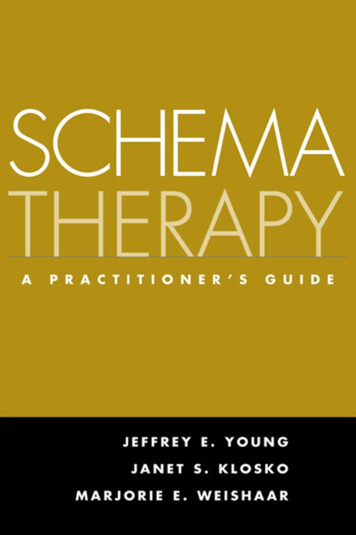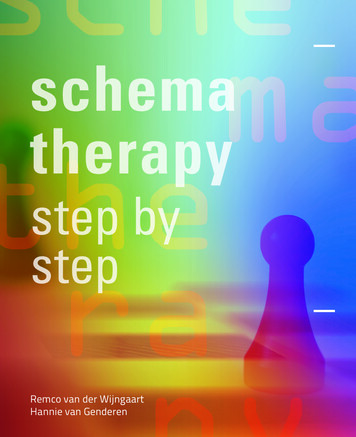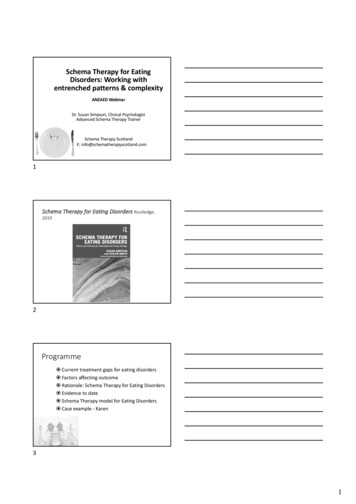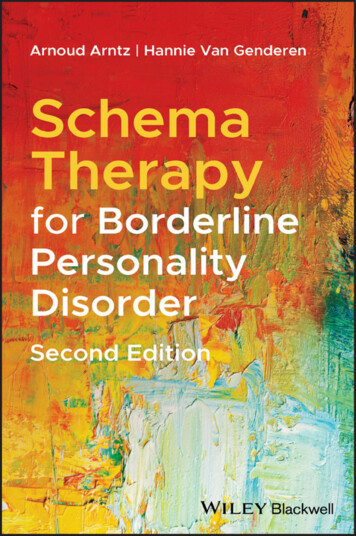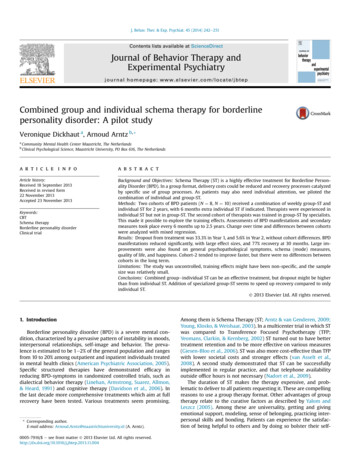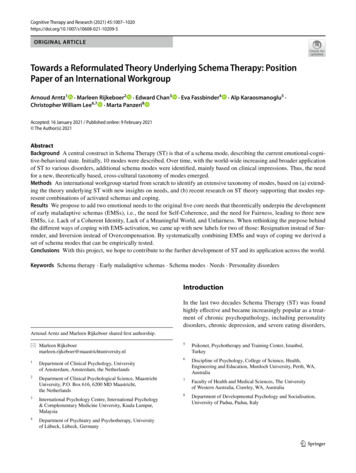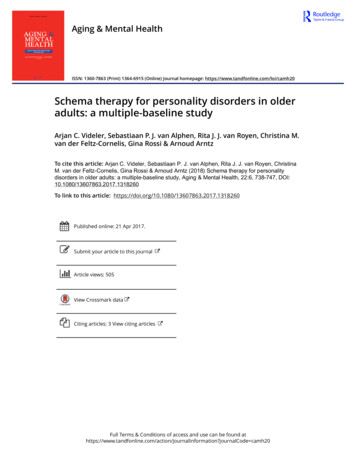
Transcription
Aging & Mental HealthISSN: 1360-7863 (Print) 1364-6915 (Online) Journal homepage: https://www.tandfonline.com/loi/camh20Schema therapy for personality disorders in olderadults: a multiple-baseline studyArjan C. Videler, Sebastiaan P. J. van Alphen, Rita J. J. van Royen, Christina M.van der Feltz-Cornelis, Gina Rossi & Arnoud ArntzTo cite this article: Arjan C. Videler, Sebastiaan P. J. van Alphen, Rita J. J. van Royen, ChristinaM. van der Feltz-Cornelis, Gina Rossi & Arnoud Arntz (2018) Schema therapy for personalitydisorders in older adults: a multiple-baseline study, Aging & Mental Health, 22:6, 738-747, DOI:10.1080/13607863.2017.1318260To link to this article: shed online: 21 Apr 2017.Submit your article to this journalArticle views: 505View Crossmark dataCiting articles: 3 View citing articlesFull Terms & Conditions of access and use can be found ation?journalCode camh20
AGING & MENTAL HEALTH, 2018VOL. 22, NO. 6, 8260Schema therapy for personality disorders in older adults: a multiple-baseline studyArjan C. Videler a, Sebastiaan P. J. van Alphenb,c, Rita J. J. van Royend, Christina M. van der Feltz-Cornelise,f,Gina Rossib and Arnoud Arntz gaDepartment of Geriatric Psychiatry, GGz Breburg, Tilburg, The Netherlands; bDepartment of Clinical and Life Span Psychology, Vrije UniversiteitBrussel (VUB), Brussels, Belgium; cDepartment of Geriatric Psychiatry, Belgium and Mondriaan Hospital, Heerlen-Maastricht, The Netherlands;dCenter for Psychotherapy, Beuningen, The Netherlands ; eTranzo Department, Tilburg University, Tilburg, The Netherlands ; fGGz Breburg, ClinicalCenter of Excellence for Body, Mind and Health, Tilburg, The Netherlands.; gDepartment of Clinical Psychology, University of Amsterdam,Amsterdam, The NetherlandsABSTRACTARTICLE HISTORYObjective: No studies have been conducted yet into the effectiveness of treatment of personalitydisorders in later life. This study is a first test of the effectiveness of schema therapy for personalitydisorders in older adults.Method: Multiple-baseline design with eight cluster C personality disorder patients, with a meanage of 69. After a baseline phase with random length, schema therapy was given during thefirst year, followed by follow-up sessions during six months. Participants weekly rated thecredibility of dysfunctional core beliefs. Symptomatic distress, early maladaptive schemas, qualityof life and target complaints were assessed every six months and personality disorder diagnosiswas assessed before baseline and after follow-up. Data were analyzed with mixed regressionanalyses.Results: Results revealed significant linear trends during treatment phases, but not duringbaseline and follow-up. The scores during follow-up remained stable and were significantlylower compared to baseline, with high effect sizes. Seven participants remitted from theirpersonality disorder diagnosis.Conclusion: Schema therapy appears an effective treatment for cluster C personality disorders in olderadults. This finding is highly innovative as this is the first study exploring the effectiveness ofpsychotherapy, in this case schema therapy, for personality disorders in older adults.Received 8 January 2017Accepted 7 April 2017IntroductionThe prevalence rate of personality disorders (PDs) amongolder adults over the age of 65 years old was 8% in US community samples (Schuster, Hoertel, Le Strat, Manetti, & Limosin, 2013). Moreover, PDs appeared strongly associated withdisability, somatic problems and mental disorders (Schusteret al., 2013) as well as medical resource utilization (Powers,Strube, & Oltmanns, 2014). Notwithstanding, treatment of thiscomplex patient group is highly underexplored (Van Alphenet al., 2015; Van Alphen, Derksen, Sadavoy, & Rosowsky,2012). In a Delphi study on diagnosis and treatment of PDs inolder adults, conducted in the Netherlands and Belgium (VanAlphen et al., 2012), which was recently cross-validated in theUS (Rosowsky, Young, Malloy, Van Alphen, & Ellison, 2016),experts agreed that existing evidence-based therapies for PDsin younger age groups are also applicable to older adults over60 years of age. However, still therapeutic nihilism prevailsamongst clinicians and researchers concerning the feasibilityand effectiveness of psychotherapy for PDs in later life. Someauthors believe that the aim of changing pathological aspectsof personality is not possible in older adults, because of therigidity of lifelong dysfunctional patterns or the consequencesof cognitive and physical decline (Segal, Coolidge, & Rosowsky, 2006; Van Alphen et al., 2012). This could explain why noeffectiveness studies have been conducted yet into the treatment of PDs in later life as the main focus of therapy. Thereare only two studies into the treatment of depression withCONTACT Arjan C. Videlera.videler@ggzbreburg.nl 2017 Informa UK Limited, trading as Taylor & Francis GroupKEYWORDSOlder adults; personalitydisorders; clinical trial;psychotherapy; schematherapycomorbid PDs and PD features. One small randomized controlled trial (RCT) in 37 older adults explored the effectivenessof dialectical behavior therapy combined with pharmacotherapy for depression and comorbid PDs, compared to pharmacotherapy as stand-alone treatment (Lynch, Cheavens,Cukrowitz, Thorp, Bronner, & Beyer, 2007). The combinedtreatment did not improve depressive symptoms over medication alone, but only was superior with respect to improvedinterpersonal sensitivity and interpersonal aggression. Thesecond study examined short group schema therapy (SCBT-g)in 31 older adults with depression and comorbid PDs or PDfeatures with a pre-mid-post design (Videler, Rossi, Schoevaars, Van der Feltz-Cornelis, & Van Alphen, 2014). A mediumeffect size was found for reduction of depressive symptoms,early maladaptive schemas (EMS) and schema modes. However, treatment effect on the comorbid PD diagnosis was notassessed. Furthermore, this treatment did not involve experiential techniques, like imagery rescripting and chairwork,which are considered more powerful at achieving change atan emotional level than cognitive-behavioral techniques andthus at influencing EMS (Arntz & Van Genderen, 2012). Insum, these two studies do show the feasibility of psychotherapy for comorbid PDs in later life, but they shed no light onpsychotherapy for PDs as the main focus of treatment in olderadults.Case studies indicate that schema therapy (ST) is applicable as a treatment of PDs in older adults (Videler, van Royen,
AGING & MENTAL HEALTHvan Alphen, Rossi, & van der Feltz-Cornelis, in press; Videleret al., 2015). Videler et al. (2014) advocated that ST connectsto the psychotherapy expectations of older adults, as it incorporates psychoeducation and is structured, skill-enhancingand problem-focused. ST is an integrative treatment, whichcombines cognitive behavior therapy (CBT), object relationstheory, gestalt therapy and attachment theory into a systematic model for the treatment of PDs (Edwards & Arntz, 2012;Young, Klosko, & Weishaar, 2003). In this model, EMS are considered core elements of PDs. The goal of treatment is todecrease the impact of these EMS and to replace negativecoping responses and schema modes with more healthyalternatives, so that patients succeed in getting their coreemotional needs met (Rafaeli, Bernstein, & Young, 2011). InST, besides CBT techniques, experiential techniques have acentral place (Edwards & Arntz, 2012). There is accumulatingevidence for the efficacy of ST in younger age groups, both intreating borderline (Giesen-Bloo et al., 2006; Nadort et al.,2009) and cluster C, paranoid, narcissistic and histrionic PDs(Bamelis, Evers, Spinhoven, & Arntz, 2014), but the effectiveness in older adults is unknown.Therefore, the aim of the present study was to assess theeffectiveness of individual ST as a treatment for PDs in olderadults, using a multiple-baseline design (Kazdin, 2010) witheight patients with a PD diagnosis.We chose the multiple-baseline design for several reasons.Often, as a first evaluation of a treatment, an open trial isdone. Contrary to an open trial, a multiple-baseline designoffers experimental control over time versus interventioneffects. Furthermore, this design has some advantages over aRCT (Kazdin, 2010). The most important advantage of a multiple-baseline design over RCTs is that this design requiresfewer participants, because participants act as their own controls, thus increasing power. Nevertheless, like a RCT, a multiple-baseline design can demonstrate significant change andalso that this change is the result of the intervention and notof time (Hawkins, Sanson-Fisher, Shakeshaft, D'Este, & Green,2007; Kazdin, 2010; Onghena, 2005). As treatment of PDs inolder adults is a hitherto relatively neglected topic, there arefew trained psychotherapists in the field, which complicatesconducting a RCT. As our aim was to test the initial effectiveness of ST in later life, without comparing ST to anotherpotentially powerful treatment, we considered the multiplebaseline design to be a good alternative for a RCT, considering the current phase of scientific research. Because thecourse of cluster B PDs appears to be much less stablethroughout the life span than that of cluster C PDs, whichespecially complicates the diagnosis of cluster B PDs (Cooper,Balsis, & Oltmanns, 2014; Van Alphen et al., 2015), we decidedto examine ST in cluster C PDs.Multiple-baseline designs require dependent variables thatare frequently assessed and are highly sensitive to change, tostudy the time and intervention effects (Kazdin, 2010). Suchvariables should represent a core aspect of the disorder thatis addressed by the treatment (i.e. short-term treatmenteffects). The frequent assessments make it possible to distinguish time and treatment effects, and allow that each case isits own control. Thus, the high number of assessments of thiscentral variable compensates for the relatively small numberof participants. As central variable, we chose the strength ofbelief participants had in their personal core beliefs, whichthey viewed as central to their PD problems. This idiosyncraticmeasure represented the EMS that are assumed to underlie739the patient's PD problems according to the ST model (Younget al., 2003).Our hypothesis was that ST would lead to a decrease ofdysfunctional core beliefs, symptomatic distress and EMS, andan increase of quality of life in cluster C PDs.MethodsParticipantsParticipants were four patients from the Department of Geriatric Psychiatry of Breburg, and four patients from the Department of Geriatric Psychiatry of Mondriaan, both mental healthinstitutes in the Netherlands. Inclusion criteria were: (1) primary diagnosis of a cluster C PD or PD not otherwise specifiedwith cluster C traits, as assessed with the Dutch version of theStructured Clinical Interview for DSM-IV PDs (SCID-II; Weertman, Arntz, & Kerkhofs, 2000). PD not otherwise specifiedwith cluster C traits was defined as meeting the general criteria for a PD while also meeting sub-threshold criteria for atleast one specific cluster C PD; (2) age 60 years old or older;(3) willingness to participate in the study. Exclusion criteriawere: (1) severe depression; (2) bipolar disorder; (3) psychoticdisorder; (4) IQ under 80; (5) substance dependence; (6) cognitive disorder (Mini Mental State Examination (Folstein, Folstein, & McHugh, 1975) under 25). During the course of thestudy, no other treatment was allowed and medication waskept constant. The eight participants were recruited fromnine patients screened for participation; one declined participation in the study. Figure 1 presents the patient flow. Table 1gives an overview of the characteristics and the treatments ofthe participants. Informed consent was obtained from all participants. The study was approved by the ethical committeesof the Maastricht University Hospital, Breburg and Mondriaan.DesignWe used a non-concurrent multiple-baseline design (Kazdin,2010), consisting of four phases. The first phase was a baselinephase varying in length from 3–8 weeks. The variation inbaseline length offers the possibility to differentiate betweentime effects and experimental effects of the treatment. Afterbaseline, weekly ST treatment sessions were given. In ouranalyses, we divided ST into two treatment phases in order toexplore the effect of experiential techniques in older adults,as some authors – and many clinicians – assume that focusingon skills and symptoms is more attainable, like in CBT (forexample, Segal et al., 2006). Therefore, we defined a CBT treatment phase, in which cognitive and behavioral techniqueswere used, and an experiential phase, where the latter wasdefined by the first introduction of experiential techniques.The two treatment phases differed in length between participants according to the ST methods described by Young et al.(2003): based upon each patient's case conceptualization, thetherapist decided when to introduce experiential techniques,in order to match the individual aspects of the patient's problems. Maximum duration of baseline, CBT and experientialphases together was 40 sessions. Finally, a six months followup phase with 10 booster sessions followed to help maintainand assess the effects of ST. During all study phases, outcomes (described in assessments) were repeatedly assessedindependently from the therapies.
740A. C. VIDELER ET AL.EnrollmentAssessed for eligibility (n 9)Excluded (n 1)Declined to participate (n 1)AllocationAllocated to intervention (n 8)Received allocated intervention (n 8)Did not receive allocated intervention (n 0)Follow-UpLost to follow-up (early success) (n 1)Discontinued intervention (n 0)AnalysisAnalysed (n 8)Excluded from analysis (n 0)Figure 1. CONSORT flow diagram.Table 1. Demographic data and treatment information of participants (N l levelbAvoidAvoidNOSPD diagnosiscDeprAdhdDeprSecondary diagnosisdADNoneADMedicationeTreatment duration prior to study (years)0.860.8Baseline sessions665CBT sessions6813Experiential sessions282822Booster sessions101010Total number of sessions444645472F1AvoidSoc prAD0.661517638Mean (SD)69.3/3.81.9/2.16.1/1.410 /5.125.4/5.38.7/1.539.9/9.3aM male, F female.1 elementary school with lower vocational training, 2 higher secondary with vocational training.cAvoid avoidant PD, OC obsessive–compulsive PD, Dep dependent PD, NOS PD cluster C Not Otherwise Specified.dDepr depression, Adhd Attention Deficit Hyperactivity Disorder, Soc P social phobia, Panic panic disorder.eAD antidepressant, Benzo benzodiazepine.Note: medication was constant in all participants.bAssessmentsAs primary outcome, strength of idiosyncratic beliefs wasassessed weekly. To formulate these beliefs, participants wereinterviewed with a semi-structured procedure to elicit 3–5idiosyncratic dysfunctional beliefs they felt to be central to theirPD problems. These dysfunctional core beliefs were then ratedweekly by the participants on a visual analog scale (VAS) on 0%–100% credibility. The ratings of the participants were put in anenvelope by them and given to the research team directly, so
AGING & MENTAL HEALTHthese ratings were unknown to the therapists, in order to minimize demand effects. Core beliefs were chosen as the primaryoutcome as they can be frequently assessed, are sensitive forshort-term change and are viewed in cognitive models as important representations of EMS deemed to underlie the PD problems (David & Freeman, 2014). The average of the ratings perassessment was taken as dependent variable (range 0–100).The Dutch SCID-II (Weertman et al., 2000) was used toassess Diagnostic and Statistical Manual of Mental Disorders(DSM) (American Psychiatric Association, 2013) PDs as secondary outcome, before baseline and after follow-up. Items arerated on a 3-point scale as absent, sub-threshold or threshold.Inter-rater agreement appeared excellent in adults with anaverage age of 35.5 years (range 18–61), with a mean value ofCohen's kappa of .84 (Lobbestael, Leurgans, & Arntz, 2011).Symptomatic distress, another secondary outcome, wasassessed with the Dutch version of the Symptom Checklist 90(SCL-90; Arrindell & Ettema, 2003) four times, before baseline,after six months of treatment, at the end of treatment andafter follow-up. The SCL-90 is a 90-item self-report measure ofoverall psychological distress. Items are scored on a 5-pointLikert scale from ‘not at all’ to ‘always.’ The reliability of theDutch SCL-90 is good, the convergent and divergent validityare satisfactory and no age-effect was found for older adultswith an average age of 73.5 years (2003). It appeared sensitiveto change in clinical settings.Idiosyncratic target complaints, as secondary outcome,were discussed with all participants in the baseline phase bythe therapists and assessed on a Likert scale of 1–9, rangingfrom ‘not at all’ to ‘can't be worse.’ Target complaints are theprimary complaints of a patient and for which there is mutualconsent between therapist and patient that these are the primary goals of treatment (Battle et al., 1966). Shorer (1970)reported considerable correlations (.71) between globalassessments of improvement and improvement on targetcomplaints. Test–retest reliability was .76 (Frey, Heckel, Salzberg, & Wackwitz, 1976). Target complaints were rated fourtimes, in the baseline phase, after six months of treatment, atthe end of treatment and after follow-up.Quality of life (QOL), also a secondary outcome, wasassessed with the Dutch World-Health-Organization-Quality-OfLife, brief version (WHOQOL-BREF; Trompenaars, Masthoff, VanHeck, Hodiamont, & De Vries, 2005). The WHOQOL-BREF is a26-item self-report measure, which is rated along a 5-point Likert scale. In two samples of older adults, with mean ages of 73and 76 years, reliability was good and the construct validity satisfactory (Kalfoss, Low, & Molzahn, 2008). The WHOQOL-BREFwas rated four times, before baseline, after six months of treatment, at the end of treatment and after follow-up.EMS, as final secondary outcome, were measured using theDutch Young Schema Questionnaire (YSQ; Sterk & Rijkeboer,1997). The questionnaire consists of 205 items, which arephrased as negative core beliefs and rated along a 6-point Likert scale. The YSQ showed good reliability and convergentand discriminant validity in a clinical sample with a mean ageof 33.9 years (range 18–74; Rijkeboer & Van den Berg, 2006),and was rated four times, before baseline, after six months oftreatment, at the end of treatment and after follow-up.ProcedurePatients with a primary multidisciplinary diagnosis of a clusterC PD, who met the inclusion criteria, were approached by the741first author, until four participants were included at both sites.Potential participants were fully informed about the studyand gave written consent to participate. One patient with anobsessive–compulsive PD decided not to participate; he preferred medication over ST. The SCID-II was applied to assessPD diagnosis. In the treatment phases, ST, according to themethods described by Young et al. (2003), was provided inweekly sessions by two therapists (with 6 and 15 years ofexperience). Treatment integrity was monitored by means ofsupervision by the third author, a certified ST supervisor. Toprovide feedback, the treatment of each participant was discussed in supervision at least 10 times and of each participantat least four therapy sessions were filmed and viewed bysupervisor and psychotherapist together. In the CBT phase,underlying EMS were targeted by cognitive and behavioraltechniques. The experiential phase started with the use ofexperiential techniques such as imagery rescripting and chairwork (Edwards & Arntz, 2012; Young et al., 2003). The numberof treatment sessions was maximized at 40 sessions, althoughstart of the booster sessions was allowed earlier if therapist'sand participants’ agreed treatment goals were reached; thus,mean length of treatment was somewhat shorter than 40 sessions (see Table 1). During the booster phase, in the last sixmonths of treatment, a maximum of 10 sessions were dedicated to stabilize the progress the participants had made.Statistical analysisCore beliefsMixed regression analyses were used to assess the differencesbetween the treatment and follow-up phases on the onehand, and baseline on the other hand, in average scores andlinear change. The fixed model part consisted of (1) a generallinear time effect, starting with time 0 when the first assessment was taken for an individual, (2) dummy indicators forthe CBT, experiential and follow-up phases (thus contrastingeach to baseline) and (3) four centered time-within-conditioncovariates, one for every phase, to assess time-by-phase interaction, that is, changes in the time effect across phases (cf.Arntz, Sofi, & Van Breukelen, 2013; Vlaeyen, De Jong, Geilen,Heuts, & Van Breukelen, 2001). The random model part consisted of an AutoRegressive-Moving-Average model(ARMA11) for the within-subject covariance structure. Random slopes to allow inter-individual variation in time and condition effects led to reduced fit of the model or convergenceproblems, and were therefore not included.The analytic strategy was to first test for a general timeeffect, next to assess the full model with all predictorsentered, and then to delete in backward fashion the time-byphase interactions that were non-significant. If the main timeeffect was non-significant, it was deleted at the last step. Thetime effect within baseline was also tested separately for thebaseline assessments only. Cohen's d for the core beliefs werecalculated as effect size of change at the end of a phase withrespect to baseline: d the mean outcome differencebetween baseline and current phase, derived from the fixedpart of the mixed regression divided by the standard deviation of the residual outcome variance (the patient-specificoutcome mean per phase has as variance random intercept(between-subject variance) (residual (within-subject) variance/number of measurements per phase); the square root ofthis subject-specific variance is the denominator for d.
742A. C. VIDELER ET AL.Other measuresFor the analysis of symptoms, target complaints, QOL andEMS, an unstructured model fitted better for the within-subject covariance structure. For these measures, Cohen's d wassimilarly calculated, but only as effect size of the changebetween follow-up and baseline, with standard deviation ofthe baseline as denominator.ResultsAttritionParticipant 4 was considered recovered by herself and thetherapist after the CBT phase and declined participation inthe follow-up phase. She did fill out all measures four times,however, and although she did not participate in the finalSCID-II interview, we did not exclude her from the analyses.tested as single predictor, t(37.67) ¡7.37, p 0.001. With allpredictors entered, the time-within-baseline and time-withinfollow-up effects appeared to be non-significant, p's .35.After stepwise deleting, the main effect of time appeared tobe non-significant and was therefore also deleted. Table 2presents the final results of the mixed regression analysis. Themain effect of treatment (i.e. the change at the middle ofboth treatment phases compared to baseline) was significant,as was the main effect of follow-up (as compared to baseline).The time-within-treatment effect was significant, showing asteep decrease of credibility of core beliefs, both in the CBTphase and in the experiential phase. Effect sizes of treatmentversus baseline, and follow-up versus baseline were very high;note that these represent not the middle point of phases butthe end point of phases. Figure 3 depicts the predicted meansfrom the analysis.Core beliefsSymptomatic distressThe individual VAS-scores of the credibility of dysfunctionalcore beliefs during the different phases are shown in Figure 2.During baseline, the time effect was non-significant, F(1, 4.83) 1.75, p .25. Visual inspection suggests decreases in credibility of dysfunctional core beliefs during the treatmentphases in all eight participants, and lower scores during follow-up than during baseline in all but participant 4. Mixedregression revealed a significant linear effect of time whenThe individual scores of the participants on the SCL-90 aregiven in Figure 4(a) (see Figure 4(a)). Visual inspection suggests that all scores decreased, except those of participants 2and 4. All changes appeared significant including that of participant 2. Participant 4 left treatment after the CBT phase.Figure 4(b) shows the predicted means from the analysis (seeFigure 4(b)). Effect size of treatment from baseline to followup was high (1.29; see Table 2).Figure 2. Individual averaged credibility ratings of core beliefs during time.
AGING & MENTAL HEALTHTable 2. Results of mixed regression analyses.ParameterbCore beliefsIntercept74.678CBT phase¡10.455Exp. phase¡39.515Follow-up¡56.146Time CBT¡1.117Time exp.¡1.109SCL-90Intercept203.00CBT phase¡26.625Exp. complaintsCBT phase¡2.335Exp. phase¡3.273Follow-up¡3.626YSQIntercept2.753CBT phase¡.176Exp. Phase¡.526Follow-up¡.595WHOQOLIntercept81.125CBT phase7.750Exp. phase9.500Follow-up11.500abcStd. ¡2.56412.5582.5691.8793.315p 0.001 0.001 0.001 0.00100.002 0.001 0.0010.0940.0080.001 0.0010.0080.001 0.001 0.001.178.048.037 0.001.037.1020.013743Effect sizea (Cohen's 629Effect sizes calculated as change with respect to baseline, with baseline SD as denominator. Change based on the estimates from the mixed regression model.Effect size based on end of phase estimated value minus estimated baseline value, with SD based on mixed regression ARMA11 variance of the baseline values. Note that reported phase effects (CBT, experiential, follow-up) are mid-phase effects, not end-of-phase effects.Effect size based on end of phase estimated value minus end of previous phase estimated value, with SD based on mixed regression ARMA11 variance of thebaseline values.Target complaintsThe individual target complaints are shown in Figure 4(c) (seeFigure 4(c)). Again, visual inspection suggests a decrease intarget complaints scores in all participants but one, participant 2. This participant had three target complaints and hismean target complaint's score remained high, probablybecause one of those was unaffected as it was determined byhis comorbid Attention Deficit Hyperactivity Disorder (ADHD).Figure 3. Predicted means of the credibility of core beliefs.The predicted means from the analysis are shown in Figure 4(d) (see Figure 4(d)). Effect size of treatment from baseline tofollow-up was very high (5.864; see Table 2).Quality of lifeIndividual scores on the WHOQOL-BREF are shown in Figure 5(a) (see Figure 5(a)). All scores improved, except for participant
744A. C. VIDELER ET AL.Figure 4. Symptomatic distress and target complaints. (a) Individual SCL-90 scores during time. (b) Predicted means of the SCL-90. (c) Individual averaged targetcomplaints during time. (d) Predicted means of averaged target complaints.5. The predicted means from the analysis are shown inFigure 5(b) (see Figure 5(b)). Effect size of treatment frombaseline to follow-up was medium (0.629; see Table 2).Early maladaptive schemasScores on the YSQ are shown in Figure 5(c) (see Figure 5(c)).Visual inspection suggests that the scores of five participantsimproved, and the scores of three participants did not change(participants 1, 3 and 4). The predicted means from the analysis are shown in Figure 5(d) (see Figure 5(d)). Effect size oftreatment from baseline to follow-up was very high (1.01; seeTable 2).Personality disorder diagnosisAll seven participants, whose PD diagnosis was assessed bothat baseline and at follow-up, did not meet full criteria for aDSM PD diagnosis anymore at follow-up, again using boththe general criteria for a PD and the cut-off for each specificPD for those patients who met the criteria of a specific ClusterC PD at baseline. The mean number of PD criteria decreasedfrom baseline to follow-up from 13.71 with a SD of 2.69, to4.57 with a SD of 2.44 (t 5.959, df 6, p 0.01), with a veryhigh effect size (d 3.56).DiscussionWe investigated ST as a treatment for PDs in older adults,using a multiple-baseline design. We found strong effects ofST on the credibility of dysfunctional core beliefs, symptoms,QOL and EMS. Mixed regression analyses revealed no evidence for significant time effects within baseline and followup phases, whereas the linear time effect during ST wasstrong, indicating that ST already had a positive impact onoutcome during treatment. The general time effect disappeared after treatment conditions were entered into themodel, indicating that it is highly unlikely that effects can beattributed to a time effect. Of the seven participants reassessed with the SCID-II at follow-up, all remitted from PD diagnosis. These results corroborated our hypotheses that STwould lead to a decrease of dysfunctional core beliefs, symptomatic distress and EMS, and an increase of QOL in cluster CPDs. Our finding that ST has a considerable positive effect onPDs in later life provides us with innovative results. This is thefirst study exploring the effectiveness of psychotherapy, inthis case ST, for PDs as the main focus of treatment in ol
disorders in later life. This study is a first test of the effectiveness of schema therapy for personality disorders in older adults. Method: Multiple-baseline design with eight cluster C personality disorder patients, with a mean age of 69. After a baseline phase with random length, schema therapy was given during the

